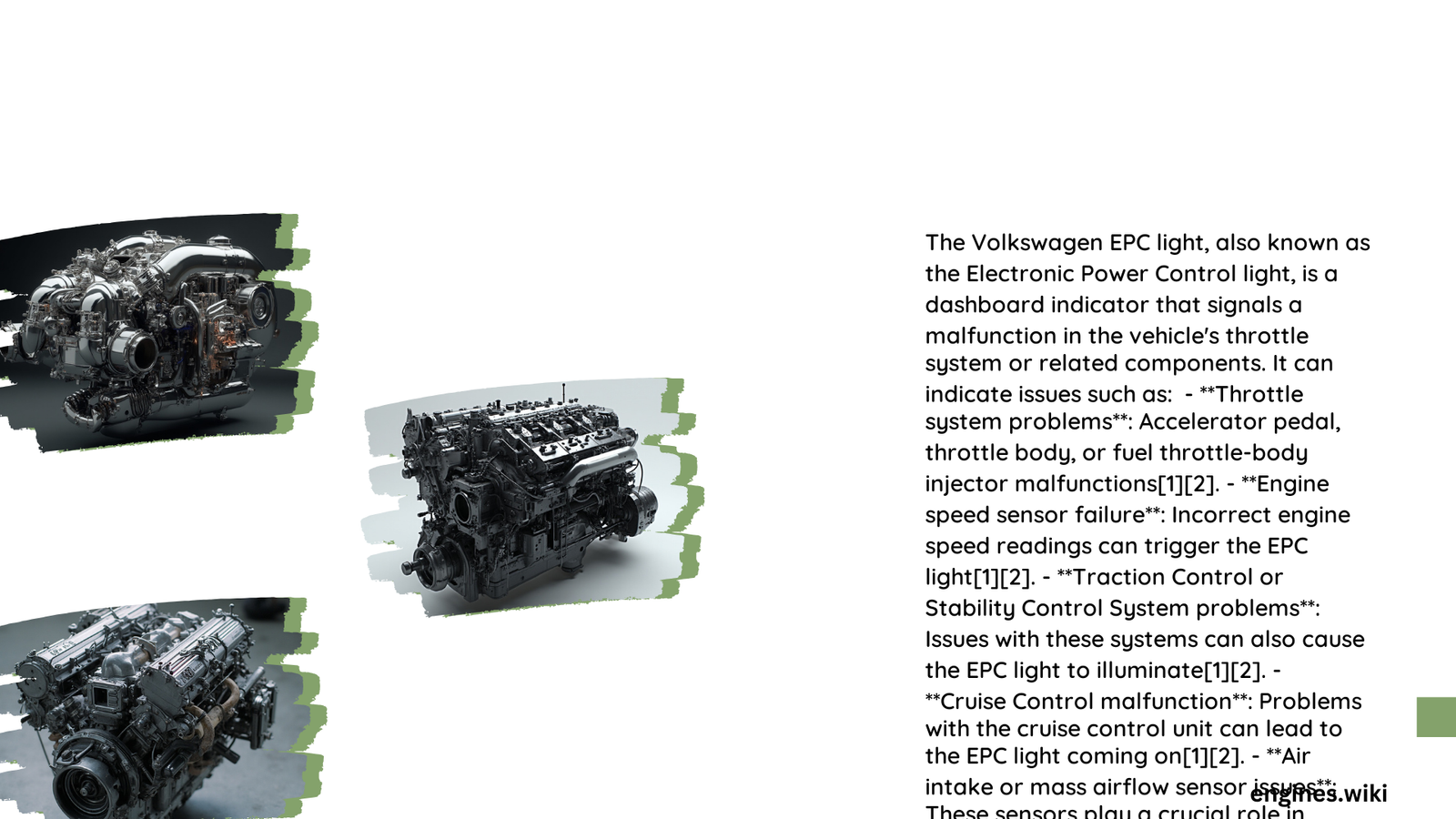The Check Engine Light EPC (Electronic Power Control) is a warning indicator found in Volkswagen Group vehicles, including Audi, Porsche, and Škoda. It signals issues with the throttle system, traction control, or cruise control. When illuminated, it can cause reduced engine power and performance. Understanding the causes, troubleshooting steps, and reset procedures for the EPC light is crucial for maintaining your vehicle’s health and performance.
What Does the Check Engine Light EPC Indicate?
The EPC light is a critical warning system in modern vehicles, particularly those from the Volkswagen Group. When this light illuminates on your dashboard, it’s signaling potential issues with:
- Throttle system
- Traction control
- Cruise control
- Various sensors related to engine performance
The activation of this light often results in:
- Reduced engine power
- Sluggish acceleration
- Limited top speed
- Possible “limp-home” mode activation
What Are the Common Causes of the Check Engine Light EPC?

Several factors can trigger the EPC light:
- Throttle System Issues
- Faulty throttle body
- Malfunctioning throttle pedal
-
Problems with the cruise control unit
-
Sensor Malfunctions
- Crank or cam position sensor failure
- Mass airflow sensor (MAF) issues
- Intake air temperature sensor (IAT) problems
- Engine coolant temperature sensor (ECT) faults
-
Oxygen sensor (O2) malfunctions
-
Fuel System Problems
- Fuel metering issues
- Timing discrepancies
-
Emissions system malfunctions
-
Electrical Faults
- Wiring issues
- Dead battery
- Failing alternator
-
Loose cables affecting baseline voltage
-
Brake and Traction Control Issues
- ABS sensor problems
- Brake pressure sensor faults
-
Brake pedal switch malfunctions
-
Low Oil Levels
- Can trigger the EPC light due to potential engine damage
While specific frequency data isn’t available, throttle body failures and sensor malfunctions are often cited as primary causes for EPC light activation.
How to Troubleshoot the Check Engine Light EPC?
Follow this step-by-step procedure to diagnose the issue:
- Identify Warning Lights
-
Note the EPC light and any other illuminated warning indicators
-
Use an OBDII Scanner
-
Connect a scanner to retrieve trouble codes
-
Analyze Trouble Codes
-
Interpret codes to identify affected systems or components
-
Perform Visual Inspection
-
Check throttle body, sensors, wiring, and related components
-
Conduct Diagnostic Tests
-
Test identified components (e.g., throttle body, sensors)
-
Repair the Issue
- Based on diagnosis, perform necessary repairs or replacements
Timeframes for troubleshooting can vary from minutes to hours, depending on the complexity of the issue. Common challenges include correctly interpreting trouble codes and identifying intermittent faults.
What is the Reset Procedure for the Check Engine Light EPC?
To reset the EPC light:
- Fix the Underlying Issue
-
Ensure the root cause is addressed before resetting
-
Use an OBDII Scanner
-
Connect the scanner to the vehicle’s OBDII port
-
Clear Trouble Codes
-
Follow scanner instructions to erase stored codes
-
Verify Dashboard
- Start the engine and confirm the EPC light is off
Required equipment:
– OBDII scanner (cost: $20-$100 for DIY)
Professional reset costs can range from $50 to $200, depending on the issue’s complexity and labor rates.
What Are the Potential Consequences of Ignoring the Check Engine Light EPC?
Ignoring the EPC light can lead to:
- Increased Engine Damage
-
Unaddressed issues may cause more severe engine problems
-
Reduced Fuel Efficiency
-
Engine running in ‘safe mode’ can decrease fuel economy
-
Safety Risks
-
Compromised vehicle performance may lead to unsafe driving conditions
-
Higher Repair Costs
-
Delaying repairs often results in more expensive fixes later
-
Failed Emissions Tests
- EPC-related issues can cause emissions test failures
It’s crucial to address the EPC light promptly to avoid these potential consequences.
How Can Regular Maintenance Prevent Check Engine Light EPC Issues?
Preventive maintenance can significantly reduce EPC light occurrences:
- Regular Oil Changes
- Frequency: Every 3,000-7,500 miles (depending on vehicle and oil type)
-
Benefit: Prevents low oil levels that can trigger EPC light
-
Throttle Body Cleaning
- Frequency: Every 30,000-60,000 miles
-
Benefit: Prevents throttle system issues, a common EPC light trigger
-
Sensor Inspections
- Frequency: During routine service checks
-
Benefit: Early detection of sensor malfunctions
-
Electrical System Check
- Frequency: Annually or when experiencing electrical issues
-
Benefit: Prevents voltage-related EPC light triggers
-
Fuel System Maintenance
- Frequency: Every 30,000 miles or as recommended by manufacturer
- Benefit: Prevents fuel system issues that can activate EPC light
By following these maintenance practices, you can significantly reduce the likelihood of encountering EPC light issues.
What Are the Differences Between the Check Engine Light and EPC Light?
While both lights indicate vehicle issues, they have distinct meanings:
| Aspect | Check Engine Light | EPC Light |
|---|---|---|
| Meaning | General engine or emissions issues | Specific to throttle system, traction control, or cruise control |
| Severity | Can indicate minor to major problems | Often indicates more immediate concerns |
| Vehicle Response | May not affect immediate performance | Often results in reduced power or ‘limp-home’ mode |
| Common in | Most vehicle makes | Primarily Volkswagen Group vehicles |
| Diagnostic Approach | Requires OBDII scanner for specific codes | May require specialized VW Group diagnostic tools |
Understanding these differences can help you respond appropriately when either light illuminates.
References:
1. https://www.jdpower.com/cars/shopping-guides/what-does-epc-mean-on-a-car
2. https://www.loubachrodtvw.com/blogs/2289/uncategorized/volkswagen-epc-light/
3. https://www.volksmasterltd.co.uk/what-does-the-epc-warning-light-mean/
